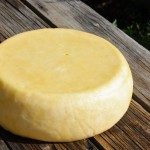Canadian version of Welsh Caerphilly Cheese
This recipe is from 200 Easy Homemade Cheese Recipes by Debra Amrein-Boyes Makes about 4 pounds (2kg): 12 % yield Ntala Quintilio teaches cheese making classes and I made this recipe with her: 58517 Range Road 60, RR2 Barrhead, AB T7N 1N3. (780) 305-2377
Servings: 50
Ingredients
- 16 quarts whole milk
- ¼ teaspoon mesophilic culture
- ¼ teaspoon Aroma mesophilic culture
- ¾ teaspoon calcium
- ¾ teaspoon liquid rennet
- 18 % Saturated brine (5 parts water to 1 part salt)
- wax optional
Materials:
- thermometer
- non-reactive double boiler that will hold 16 litres
- large tomme mould
- cheese cloth
- slotted spoon
- long spatula for cutting the curd
- draining mats
- aging cave
Instructions
- Take your milk out of the fridge one to two hours ahead of making the cheese, depending upon the size of the milk containers (the larger, the longer)
- Sterilize all equipment and counterspace
- In a hot water bath over medium heat, warm milk to 90°F/32°C stirring gently; turn heat off
- Sprinkle cultures over surface and let hydrate for 5 minutes; then mix well using an up and down motion to fully incorporate without breaking the surface
- Cover and let ripen for 30 minutes maintaining the temperature of 90°F/32°C
- Dilute calcium chloride in ¼ cup cool water if not using raw mile; add to milk and using the same up and down motion to fully incorporate without breaking the surface, then do the same with the rennet (calcium chloride must go first)
- Cover and sit, maintaining a temperature of 90°F/32°C for 45 minutes, or until the curd gives a clean break; if necessary, sit an extra 5-10 minutes
- Ensure a clean break, then cut the curd into ½ inch cubes; let stand for 5 minutes to firm, maintaining temperature
- Turn heat back on and slowly heat curds to 95°F/35°C over 30 minutes: adjust heat as necessary to ensure it takes 30 minutes to warm the curd to this temperature, stirring slowly to ensure uniform curds
- Cover and hold curd for 45 minutes, maintaining temperature
- Prepare mould with wet cheese cloth; place prepared mould underneath cheesecloth lined colander to catch the warm whey: this will warm the mould
- Fill mould with curds, piling them higher in the centre; pull cloth up neatly over the curds and fold snuggly over the top with as few wrinkles as possible
- Put on the top or the follower; press at medium weight for 30 minutes
- Turn over, redress cheese and place back in the mould other side up; continue pressing at medium pressure for several hours, or overnight
- Remove cheese from press; unwrap and place in brine solution for 20 hours, turning over after 10 hours
- Remove from brine; dry on a cheese mat placed on a cheese rack at room temperature for 2 to 3 days, or until dry to the touch (turn twice a day)
- (Go to #20 for waxing option now, or) Place cheese on a clean cheese mat in a ripening container inside the cave; ripen at 50°F-54°F/10°C-12°C 85% humidity turning daily maintaining humidity by adjusting the lid in the ripening container, as necessary
- After about 2 weeks a whitish grey mould should appear; continue turning daily until a thicker crust forms
- After about 4 weeks, the cheese will begin to soften just under the crust, possibly becoming runny: eat it within 2 to 3 months (it will not keep as long as the waxed version)
